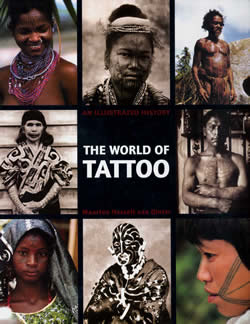THE WORLD OF TATTOO - AN ILLUSTRATED HISTORY
By Maarten Hesselt van Dinter
BOOK REVIEW BY LARS KRUTAK
 Maarten
Hesselt van Dinter's The World of Tattoo (KIT Publishers) is a visually
stunning new book that explores the personal and collective acts of
human transformation through the tradition of indelible marking among
indigenous peoples and other tattoo communities, past and present.
Throughout history, people have applied tattoos to living skin in their
attempts to beautify, heal, empower, or carry the body into the
afterlife. And as all tattoo bearers are participants in shared pain and
recuperation, the skin is the location where individual and collective
identity meets. Maarten
Hesselt van Dinter's The World of Tattoo (KIT Publishers) is a visually
stunning new book that explores the personal and collective acts of
human transformation through the tradition of indelible marking among
indigenous peoples and other tattoo communities, past and present.
Throughout history, people have applied tattoos to living skin in their
attempts to beautify, heal, empower, or carry the body into the
afterlife. And as all tattoo bearers are participants in shared pain and
recuperation, the skin is the location where individual and collective
identity meets.
The author spent the better part
of ten years gathering the material for this book visiting dusty archives in
Europe, the United States, and Polynesia for rare images and texts that
comprise the 300-page World of Tattoo. Peeking at the book's contents page,
it seems that van Dinter has left no stone unturned in his encyclopedic
quest to document each of the world's tattoo cultures, since he explores the
diversity of tattooing on every inhabitable continent known to humankind.
With the popularity of tattooing
on the rise, tattoos have gained respectability as a form of fine art.
Although the range of motivations for becoming tattooed (e.g., enhanced
attractiveness and spirituality, rebellion from society) are as varied as
the tattoo styles available, tattooing has become not only a celebration of
self and the human body, but also a celebration of the tattoo community. And
in this way, The World of Tattoo is a book that celebrates our planet's
tattoo cultures, even though tattooing practices, styles, and designs have
increasingly moved from one cultural context to another, and tattooing
practices have been given new meanings as they have been adopted by various
segments of the human population.
For example, since tribal
tattooing was first brought to the West from Polynesia and Japan in the 18th
century, it has been borrowed many times over by servicemen, carnival
entertainers, aristocrats, convicts, members of the working class, bikers,
musicians, entertainers, athletes, and seemingly everyone else in between.
But what has emerged in the 21st century from this kaleidoscopic mix of
traditional and more contemporary forms of tattooing practice is a modern
tattoo community that allows people to experiment with new identities and to
cross boundaries of gender and cultural difference. Of course, this movement
also includes the revitalization of tattooing practices in places such as
Polynesia and elsewhere where tribal forms of tattooing were once in danger
of disappearing.
Yet in many other parts of the
indigenous world, tattooing practices are steadily on the decline. Disease,
missionization, colonial administration, forced relocation, and modernity
have all paved the way for a relinquishing of ancient tattoo customs;
customs that were deeply rooted within the memory of ancestral and everyday
life, and that defined local perceptions of identity through a wide array of
visual symbolism.
Maarten's fully indexed book not
only examines these threads, but also establishes new ways of seeing and
reading the messages encoded in ancient and more contemporary forms of
tattooing. And whether tattoos were worn as forms of ornament, medicine, or
as religious devices, they defined local perceptions of existence that were
spelled out on the surfaces of the body.
However, no matter how expansive
or visually stunning a work of literary art may be, there are always a few
shortcomings. Although van Dinter's book contains a literature section, the
text is not rigorously cited with bibliographical references making it less
"anthropological" because it is difficult to locate any of the source
materials covered. More importantly, the author's primary source materials
on indigenous peoples are derived from archives and published texts and not
from actual encounters or interviews with living and breathing individuals.
Perhaps this fact alone explains why there are several misattributions and
misspellings in The World of Tattoo, but these are only minor considerations
which should not keep this elegantly designed book from finding a home at
your family coffee table, bookshelf, or local tattoo shop.
You can purchase your copy of
The World of Tattoo at most local book outlets in North America and Europe
or via
http://www.amazon.com.
For more information on the
author of The World of Tattoo, and a listing of his forthcoming literary
projects, visit Maarten's website at:
www.hesseltvandinter.com
|